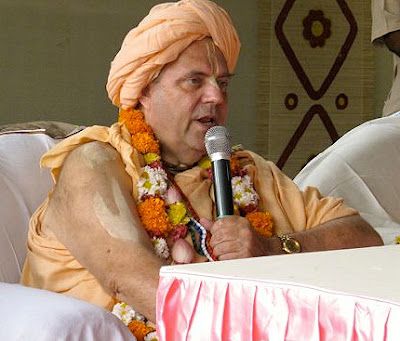Written by Ananda Vrindavan Dasi
After more than three years, Kadamba Kanana Swami visited the USA again, this time focusing his visit on the communities of New Vrindavan, Gita Nagari, New York and New Jersey.
New Vrindavan (17-25 June)
 Kadamba Kanana Swami landed at Pittsburgh airport on 17 June and then drove to New Vrindavan, West Virginia – the beautiful, picturesque home of Sri Sri Radha-Vrindavancandra, Gaura-Nitai, Jagannath-Baladeva-Subhadra, Sri Nataji and Prahlad-Nrsimhadev. It is a huge property owned by devotees, with one hundred and fifty residents. There is also the famous Palace of Gold, many cows, as well as lodges and cabins overlooking beautiful lakes filled with swans, fish, peacocks and other natural wildlife.
Kadamba Kanana Swami landed at Pittsburgh airport on 17 June and then drove to New Vrindavan, West Virginia – the beautiful, picturesque home of Sri Sri Radha-Vrindavancandra, Gaura-Nitai, Jagannath-Baladeva-Subhadra, Sri Nataji and Prahlad-Nrsimhadev. It is a huge property owned by devotees, with one hundred and fifty residents. There is also the famous Palace of Gold, many cows, as well as lodges and cabins overlooking beautiful lakes filled with swans, fish, peacocks and other natural wildlife.
The next morning Maharaj gave the Srimad-Bhagavatam class. As this was his very first visit to New Vrindavan, a resident of the community, Malati Devi (ACBSP), introduced him to devotees in many chosen words. Amidst other nice things, she said that Kadamba Kanana Swami is well known for his acute intelligence and ability to comprehend things!
Vrindavan das, Maharaj’s disciple who is one of the prominent leaders of the community, was very keen to make Maharaj’s visit memorable to all. Vrindavan das is very devoted, caring and supportive to the devotees and their various needs. Hari-bhakti devi dasi, Maharaj disciple originally from Holland, also lives in the community and has a very special service. She very dedicatedly attends to Srila Prabhupada’s murti at Srila Prabhupada’s puspa samadhi in the famous Palace of Gold. This is one of the three existing samadhis of Srila Prabhupada in the whole world.
Krsna-nam, a disciple from Bulgaria who was initiated this year in Radhadesh and living in the USA now, drove from Chicago to render personal service to Maharaj. Savitri devi dasi came from Atlanta and Sukhayanti devi dasi from Canada to enjoy the blissful company of their beloved Gurudev. Vasudev das, also originally from Holland and now living in New York where he serves as a head pujari at the Bhakti Center, joined Maharaj at the Gita Nagari farm.
Upon arriving at New Vrindavan, Maharaj said that it was such a special, historical place as Srila Prabhupada had visited it three times and stayed there for a significant amount of time. “We are in the Lilamrita now!” Maharaj exclaimed happily to the small group of gathered disciples.


Furthermore, in the Caitanya Caritamrta class given on 19 June, Maharaj said that this place is filled with so many services done by so many devotees. “It all started by prayers and service of Srila Prabhupada who invoked Krsna’s mercy that was capable of transforming everything.” He compared it to the story of a small sparrow who had lost her eggs in the ocean but was determined to get it back by threatening the ocean that she will dry it up by herself if her eggs were not returned. However, big Garuda with his big heart saw her determination and decided to take up her work. Maharaj remarked that devotional service is similar to that. He said that our current services provide services to so many vaisnavas to come forward and that Srila Prabhupada left the destiny of our movement in our hands. Maharaj ended by saying how simple it becomes when a vaisnava paves the way for us – otherwise it would be very complex and confusing. Please listen to this class and especially the Q&A session at the end, as there was an interesting question, “Who has prema?” posed to Maharaj, followed by his wonderful reply, as well as a question raised by Malati Devi about understanding blockages in our spiritual life from the right perspective. Recordings will be posted shortly.
Later the same day, Maharaj together with Agnidev prabhu and Vraja Krsna Prabhu were invited to chant kirtan in the supremely beautiful Palace of Gold (it represents one of eight religious wonders in the whole USA), in front of Srila Prabhupada’s murti. Despite the naturally grave atmosphere at the samadhi, devotees could not contain themselves, dancing to the tune of the famous KKS’s ‘Internal growth’ bhajan which was just the perfect melody for the occasion.


Maharaj was especially invited to New Vrindavan for the twenty-four hour kirtan festival which took place on 20-21 June. Agnidev Prabhu, Amala Harinam, Nadia-mani and Acyuta Gopi were some of the famous kirtaniyas who participated. Despite Maharaj being somewhat of a new name for many of the devotees attending, in seconds he managed to capture their minds and hearts with his roaring kirtans along with his sharp, thought provoking, always fresh and relevant lectures. Sruta-kirti Prabhu (ACBSP) was visiting New Vrindavan as well, sharing his sweet and intimate pastimes with Srila Prabhupada. He was Srila Prabhupada’s personal servant who started with that service in New Vrindavan actually. He also shared his memories of Brahmananda Prabhu, for whom he could not hide his tears of deeply felt friendship and appreciation.
On the morning of the twenty-four hour kirtan festival (20 June), Maharaj was asked to speak about the importance of chanting the holy names. He started by saying how an exciting weekend is ahead of us with lots of vaisnavas coming to chant, so we should use this great opportunity to borrow their bhava – their eagerness for glorifying Krsna. Maharaj quoted Sri Caitanya Mahaprabhu who said to his devotee, Satyaraj Khan, that the business of a vaisnava is to serve other vaisnavas and incessantly chant the holy name. So although we may sound like a squeaky door when trying to chant Hare Krsna, meaning that we are dry and have no taste for it – still we should persist on the path. “The holy name is such a river!” he exclaimed, “No doubt it will grab us and drag us in its irresistible current!” Maharaj said that he is full of expectations and anticipating with curiosity as to what the kirtan festival will bring. For more than twenty-four hours, chanting filled the huge temple room – full of different moods, flavors and rasas; and devotees surely enjoyed tasting all these variegated moods.
On 23 June, Maharaj gave Srimad Bhagavatam class focusing on the importance of humility, otherwise again and again, we will be facing punar mustika bhava – being forcefully reduced to our naturally humble position in this world. That same evening, a home program took place at the house of some senior residents of New Vrindavan, Vani Devi and Rupanuga Prabhu. Their Radha-Krsna deities took away everyone’s breathe, as Maharaj was reading from Caitanya Caritamrta. He shared his personal experiences while living in Vrindavan dham and marveled at the supreme mercy of Caitanya Mahaprabhu which leaves no room for doubt of will it work in our lives or not. He welcomed devotees to participate with their comments and then ended with singing a melody ‘As heard by the sages’ from his newest CD, simply thrilling everyone.


On 24 June, another evening home program was held on the open terrace of the lavish house of generous Nityodita prabhu (ACBSP) and Radha Devi. The view from the terrace was amazing, overlooking the beautiful Appalachian lushy hills and valleys, and showing the outlines of the old Bahulavan farm in the distance, where devotees previously used to live.
Maharaj spoke on his favorite subject: the mercy of Caitanya Mahaprabhu and how we should practice not only being on the receiving side of it, but also as an instrument of it. He spoke about the importance of honesty and how it naturally leads to humility, and that is exactly how we will manage to stay alive in our spiritual lives despite our shortcomings. Maharaj also talked about his relationship with his spiritual master, Jayadvaita Swami, in response to a question he got from the audience who wanted to know a bit more about him, and few other fascinating accounts from his personal life which instantly endeared him to all the devotees present.
That evening, the other speaker besides Kadamba Kanana Swami was Bhakti Dhira Damodar Swami, a sannyasi disciple of HH Bhakti Tirtha Swami, originally from Nigeria, who spoke of a need to overcome our deep rooted fears by taking shelter in our firm conviction that Krsna is there for us – always! He said that the Krsna consciousness society is a society for enjoyment (in our natural state of relationship with Krsna) and not for insecurities and fears.















































